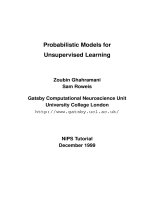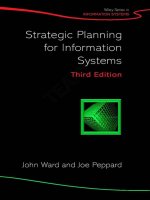Probabilistic models for dynamical systems, second edition (1)
Bạn đang xem bản rút gọn của tài liệu. Xem và tải ngay bản đầy đủ của tài liệu tại đây (10.23 MB, 328 trang )
Benaroya
Han
L & MECHANICAL ENGINEERING
Probabilistic
Models for
Dynamical Systems
E D I T I O N
e book presents a nice balance of theory and pragmatic application. It begins by
ting the foundations of probability theory as it is applied to engineering systems
d then develops fundamental engineering concepts that integrate these probabilistic
ncepts. … The book also presents a wonderful historic perspective of some of
greatest scientific and engineering minds who have made the most significant
tributions to the fields of both probability and dynamics. … This is an excellent first
t for integrating mechanical system design and probability/reliability concepts.”
R. THOMAS R. K U R F E S S, Georgia Institute of Technology, Atlanta, USA
obabilistic Models for Dynamical Systems, Second Edition is an excellent
ource for faculty to engage students in pursuit of knowledge about physical
tems which are naturally complex, nonlinear, and non-deterministic. The book is
l written and complete with a plethora of worked out examples in each chapter.”
R. ROB E RT H. B I S HOP, Marquette University, Milwaukee, USA
w in its second edition, Probabilistic Models for Dynamical Systems expands
coverage of probability theory for engineering. This new revised version introduces
dents to the randomness in variables and time-dependent functions and allows
m to solve governing equations.
s book provides a suitable resource for self-study and can be used as an all-inclusive
oduction to probability for engineering. It introduces basic concepts, and highlights
plied probability in a practical manner. With updated information and over 300
strations, this edition includes new sections, problems, applications, and examples.
graphical summaries spotlight relevant historical figures, providing life sketches,
or contributions, and relevant quotes from their works. A new chapter on control
d mechatronics rounds out the coverage.
ech.indd
K12264
0610
2013
ISBN: 978-1-4398-4989-7
Probabilistic Models for
Dynamical Systems
S E C O N D
Nagurka
SECOND
E D ITIO N
Probabilistic
Models for
Dynamical Systems
S E C O N D
E D I T I O N
Haym Benaroya
Seon Mi Han
Mark Nagurka
90000
9 781439 849897
All Pages
3/22/13
2:10 PM
solutions MANUAL FOR
Probabilistic
Models for
Dynamical
Systems
second Edition
by
Haym Benaroya
Seon Mi Han
Mark Nagurka
This page intentionally left blank
solutionS MANUAL FOR
Probabilistic
Models for
Dynamical
Systems
second Edition
by
Haym Benaroya
Seon Mi Han
Mark Nagurka
Boca Raton London New York
CRC Press is an imprint of the
Taylor & Francis Group, an informa business
CRC Press
Taylor & Francis Group
6000 Broken Sound Parkway NW, Suite 300
Boca Raton, FL 33487-2742
© 2013 by Taylor & Francis Group, LLC
CRC Press is an imprint of Taylor & Francis Group, an Informa business
No claim to original U.S. Government works
Version Date: 20140709
International Standard Book Number-13: 978-1-4398-5015-2 (eBook - PDF)
This book contains information obtained from authentic and highly regarded sources. Reasonable efforts have been
made to publish reliable data and information, but the author and publisher cannot assume responsibility for the validity of all materials or the consequences of their use. The authors and publishers have attempted to trace the copyright
holders of all material reproduced in this publication and apologize to copyright holders if permission to publish in this
form has not been obtained. If any copyright material has not been acknowledged please write and let us know so we may
rectify in any future reprint.
Except as permitted under U.S. Copyright Law, no part of this book may be reprinted, reproduced, transmitted, or utilized in any form by any electronic, mechanical, or other means, now known or hereafter invented, including photocopying, microfilming, and recording, or in any information storage or retrieval system, without written permission from the
publishers.
For permission to photocopy or use material electronically from this work, please access www.copyright.com (http://
www.copyright.com/) or contact the Copyright Clearance Center, Inc. (CCC), 222 Rosewood Drive, Danvers, MA 01923,
978-750-8400. CCC is a not-for-profit organization that provides licenses and registration for a variety of users. For
organizations that have been granted a photocopy license by the CCC, a separate system of payment has been arranged.
Trademark Notice: Product or corporate names may be trademarks or registered trademarks, and are used only for
identification and explanation without intent to infringe.
Visit the Taylor & Francis Web site at
and the CRC Press Web site at
Solutions Manual - Probabilistic Models for Dynamical Systems,
2nd Ed.
Haym Benaroya, Seon Han, Mark Nagurka, and Joey Sanchez
June 27, 2013
Contents
1 Introduction
1
2 Events and Probability
3
3 Random Variable Models
16
4 Functions of Random Variables
76
5 Random Processes
135
6 Single Degree-of-Freedom Vibration
163
7 MDOF vibration
191
8 Continuous System Vibration
228
9 Reliability
256
10 Nonlinear and Stochastic Dynamic Models
268
11 Nonstationary Models
304
12 Monte Carlo Methods
312
1
Introduction
1.1. Identify engineering and scientific applications where uncertainties can be ignored. Explain.
Solution: Generally, uncertainties can be ignored if their magnitudes are significantly smaller that the nominal (average) magnitudes. For example, for a circular cylindrical column of diameter D, with uncertainties
in the diameter of 0.001D, then it is likely that we can ignore the uncertainty in the nominal diameter when
calculating the quantities based on diameter.
1.2. Identify engineering and scientific applications where uncertainties cannot be ignored. Explain.
Solution: If the magnitude of the uncertainty is significant compared to the nominal (average) value then
it cannot be ignored. For example, for a circular cylindrical column of diameter D, with uncertainties in
the diameter of 0.1D, then we cannot ignore the uncertainty in the nominal diameter when calculating the
quantities based on diameter. It may also be that the application/the design requires a very tight tolerance
and therefore uncertainties must always be incorporated into the design.
1.3. Discuss how an engineer may ascertain whether uncertainties are important or can be ignored in
an analysis and design. Use examples in your discussion.
Solution: A design engineer will perform the design using alternate values of parameters that have uncertainties and then ascertain whether the final design is significantly different. In the simple example of the
design of a column, various diameters will be used in order to determine the necessary buckling strength.
Similarly, if there are uncertainties in the forces on a structure, then high and low values might be used to be
certain that the design will resist those forces. The use of probability makes this process more streamlined.
1.4. How can Miner’s rule for fatigue damage be extended to cases where the order of loading cycles is
important? Explain with or without using equations.
Solution: If the order of the loading cycles is important then higher weighting can be given to a particular
ordering of stress cycles. The summation has to be identical to the ordering. For example,
p
Damage =
fi
i=1
ni
,
Ni
where p is the number of stress levels, i is the ith stress cycle at ith stress level, Ni is the number of cycles
that the part can take at ith stress level, and the part fails when the damage reaches one.
1.5. How can Miner’s rule for fatigue damage be extended to cases where a cycle at stress nσ causes n
times as much damage as a cycle at stress σ? Explain with or without using equations.
Solution: In the summation it will be necessary to have factors that reflect this multiple. Tests would show
that at higher stresses failure occurs n times faster.
1
1.6. Which variables or parameters in Equations 1.3 and 1.4 are better assumed to be random variables?
Explain your choices.
Solution: CD , CI , u, u˙ are all likely candidates to be random variables. The coefficients CD , CI are experimentally determined and have significant scatter associated with their values, which depend on the fluid
speed. Similarly, fluid speed and acceleration u, u˙ are also random.
2
2
Events and Probability
Section 2.1: Sets
2.1. Give three examples of impossible events from everyday life.
Solution: Examples may include the sun rising in the West and setting in the East, water flowing upstream,
and time going backwards.
2.2. Give three examples of impossible events from fluids engineering.
Solution: Examples may include fluid with no viscosity, higher density fluid rising, and pressure head
decreasing with increasing column height.
2.3. Give three examples of impossible events from materials engineering.
Solution: Examples may include temperature dipping below 0 degrees Kelvin, massless material, inextensible metal.
2.4. Give three examples of impossible events from strength of materials.
Solution: Examples may include the proportional limit of a material exceeding the yield stress, fracture
being a reversible event, plastic deformation that is recoverable and not permanent, the sum of the forces in
a static structure being not zero, and a linear isotropic material with Poisson’s ratio greater than 0.5.
2.5. Give three examples of impossible events from mechanical vibration.
Solution: Examples may include a structure that oscillating without any forces or initial conditions on it,
for the same structure, a stiffer structure oscillating slower, a structure oscillating with unlimited speeds, a
damped oscillator having a non-decaying amplitude in free vibration, a spring with an infinite stiffness, a
free pendulum swinging indefinitely without the addition of energy, eliminating low frequency vibration in
a baseball bat when hitting a ball outside the sweet zone.
2.6. Give three examples of impossible events from thermal engineering.
Solution: Examples may include decreasing entropy without energy, increasing energy in a closed system,
and radiation without temperature.
2.7. Give three examples of certain events from everyday life.
Solution: Examples may include the sun rising tomorrow, having to fill out tax forms every year, the sun
causing the evaporation of 1 trillion tons of water daily, being summer time in the northern hemisphere when
it is winter time in the southern hemisphere, applying a force on an object results in an equal and opposite
force, and all creatures needing energy to survive.
3
2.8. Give three examples of certain events from fluids engineering.
Solution: Examples include a faster incompressible flow in a smaller diameter pipe, denser fluid sinking,
flow exerting a force on impeller.
2.9. Give three examples of certain events from materials engineering.
Solution: All materials have imperfections, a higher pressure results in a higher boiling point, a constrained
beam has a higher buckling load.
2.10. Give three examples of certain events from strength of materials.
Solution: An axial force on a column leads to compression of that column; an elastic body will always
deform if forces act on it; any beam subjected to an axial force will eventually fail; in polymer composites,
nanoparticles do not create large stress concentrations and thus do not compromise the ductility of the
polymer.
2.11. Give three examples of certain events from mechanical vibration.
Solution: If a body is oscillating, then there must be inertia; if a body is oscillating, then there is a restoring
force; there is an energy exchange mechanism between the kinetic and potential energies; when hit at the
sweet zone, the baseball bat will not be excited at its natural frequencies and therefore there will not be
energy loss due to these frequencies vibrating, resulting in more energy being transmitted to the ball.
2.12. Give three examples of certain events from thermal engineering.
Solution: Heating an object results in a higher temperature. Heating a metal object results in expansion.
Objects expand and contract at different rates.
2.13. Give an example of complementary events from everyday life.
Solution: winning/losing a game; catching/missing a train; night/day;
2.14. Give an example of complementary events from fluids engineering.
Solution: The flow may be considered laminar or turbulent.
2.15. Give an example of complementary events from materials engineering.
Solution: The material extends linearly or nonlinearly. In other words, the material may or may not obey
Hooke’s law.
4
2.16. Give an example of complementary events from strength of materials.
Solution: Examples: A material deforming elastically/plastically; a tensile test yielding expected/unexpected
results; a part failing/passing a drop test.
2.17. Give an example of complementary events from mechanical vibration.
Solution: An increase in stiffness and lower frequency.
2.18. Give an example of complementary events from thermal engineering.
Solution: The entropy of the system is increasing/decreasing.
5
2.19. Given the three events:
X = {odd numbers}
Y = {even numbers}
Z = {negative numbers} ,
obtain the following:
(a) X ∪ Y
(c) X
(e) Z
(b) X ∩ Y
(d) Y
(f) Y ∩ Z.
Solution: We are given the following:
X
Y
Z
= {odd numbers}
= {even numbers}
= {negative numbers} .
Then,
X ∪Y
X ∩Y
¯
X
¯
Y
Z¯
Y ∩Z
=
=
=
=
=
=
{All numbers (odd numbers + even numbers) }
{}=φ
{even numbers}
{odd numbers}
{positive numbers}
{negative even numbers}.
6
2.20. Extend Example 2.5 to the case where there are three shafts connecting two clutches (instead of
two shafts connected to one clutch). The shafts are numbered from left to right as 1, 2, 3. The failure of
the drive train is defined as the failure of either of the three shafts, with events defined by E1 , E2 , and
E3 , respectively. Assuming the clutches will not fail, find the following events:
(a) failure of the drive train,
(b) no failure of the drive trains, and
(c) show an illustration of de Morgan’s rule.
Solution: Define the following events:
E1
E2
E3
= breakage of shaft 1
= breakage of shaft 2
= breakage of shaft 3.
(a) The failure of the drive is defined as the failure of any one of the three shafts, or any two of the three
shafts, or all the three shafts. Using set notation, this equals
failure of drive train = E1 ∪ E2 ∪ E3 .
(b) Therefore, the event of no failure is given by the event
no failure of drive train = E1 ∪ E2 ∪ E3 .
(1)
The event of no failure can also be defined as an event where all three shafts are operational, which implies
¯2 ∩ E
¯3 .
no failure of drive train = E¯1 ∩ E
(c) Since Equations 1 and 2 must be equal to each other, we have an illustration of De Morgan’s rule,
¯1 ∩ E
¯2 ∩ E¯3 .
E1 ∪ E2 ∪ E3 = E
7
(2)
Section 2.2: Probability
2.21. Consider Figure 2.8 where dav = 50 mm and 50 shafts are manufactured. From the measurements
we observe that
25 have the diameter dav
10 have the diameter 1.01 dav
6 have the diameter 1.02 dav
5 have the diameter 0.99 dav
4 have the diameter 0.98 dav .
Sketch the frequency diagram showing appropriate numbers along the axes. Using the frequency interpretation for probability, calculate the probability of occurrence for each shaft size and verify that the
sum of these probabilities equals 1.
Solution: We are given that dav = 50 mm and the number of shafts manufactured is 50. Also, the following
measurements are observed:
25 have the diameter dav
10 have the diameter 1.01 · dav
6 have the diameter 1.02 · dav
5 have the diameter 0.99 · dav
4 have the diameter 0.98 · dav .
From this, we can draw a frequency diagram, as shown in Figure 1. Then,
Figure 1: Frequency Diagram of the Number of Shafts
8
Pr (d = 0.98dav ) =
Pr (d = 0.99dav ) =
Pr (d = dav ) =
Pr (d = 1.01dav ) =
Pr (d = 1.02dav ) =
4
50
5
50
25
50
10
50
6
50
= 0.08
= 0.1
= 0.5
= 0.2
= 0.12.
Sum of the probabilities = Pr{d = 0.98dav } + Pr{d = 0.99dav } + Pr{d = dav }
+ Pr{d = 1.01dav } + Pr{d = 1.02dav }
= 0.08 + 0.1 + 0.5 + 0.2 + 0.12 = 1.0
2.22. In your own words, explain the essential ideas of the Theorem of Total Probability, and discuss its
importance.
Solution: The total probability theorem provides a way to relate the probability of an event to all other
events with which it intersects. The importance in a practical sense is that it is sometimes easier to calculate
the intersections than the original probability.
9
2.23. Suppose Pr(E1 ) = 0.20, and Pr(E2 ) = 0.30.
(a) If E1 and E2 relate to a particular process, are any events not accounted for here? Why?
(b) If Pr(E1 ∪ E2 ) = 0.90 are these processes mutually exclusive? Why?
(c) If Pr(E1 ∪ E2 ) = 0.50, then what is the value of Pr(E1 E2 )?
Solution: The following data is given
Pr{E1 } = 0.20
Pr{E2 } = 0.30.
(a) We know that the probability of any certain event is 1. If E1 and E2 are the only two events occurring,
then the probability that any event will definitely occur is given by
Pr{E1 ∪ E2 } = Pr{E1 } + Pr{E2 } − Pr{E1 ∩ E2 }.
Even if E1 and E2 are assumed to be mutually exclusive, that is E1 ∩ E2 = 0, the probability that E1 or E2
or both occur is given by
Pr{E1 ∪ E2 } = Pr{E1 } + Pr{E2 }
= 0.20 + 0.30
= 0.50.
Here even if both events occur, the maximum probability is 0.50, which indicates that some event has been
left out.
(b) If Pr{E1 ∪ E2 } = 0.90, then there is an inconsistency, as follows:
Pr{E1 ∪ E2 } = Pr{E1 } + Pr{E2 } − Pr{E1 ∩ E2 }
So, Pr{E1 ∩ E2 } = Pr{E1 } + Pr{E2 } − Pr{E1 ∪ E2 }
= 0.20 + 0.30 − 0.90
= −0.40, which is impossible.
The maximum probability of the union is Pr(E1 ∪E2 ) = 0.50. Then the two events are mutually exclusive
because
Pr{E1 ∪ E2 } = Pr{E1 } + Pr{E2 } − Pr{E1 ∩ E2 }
So, Pr{E1 ∩ E2 } = Pr{E1 } + Pr{E2 } − Pr{E1 ∪ E2 }
= 0.20 + 0.30 − 0.50
= 0, which indicates that E1 and E2 are mutually exclusive.
If the union is less than Pr = 0.5, the intersection will have a positive probability, indicating that the
two events are not mutually exclusive.
(c) To find Pr(E1 E2 ) given Pr(E1 ∪ E2 ) = 0.50,
Pr{E1 ∪ E2 } = Pr{E1 } + Pr{E2 } − Pr{E1 ∩ E2 }
So, Pr{E1 ∩ E2 } = Pr{E1 } + Pr{E2 } − Pr{E1 ∪ E2 }
= 0.20 + 0.30 − 0.50
= 0.00.
10
2.24. Suppose Pr(A) = 0.5, Pr(A|B) = 0.3, and Pr(B|A) = 0.1, calculate Pr(B).
Solution: We are given the following:
Pr {A} = 0.5
Pr {A|B} = 0.3
Pr {B|A} = 0.1.
To calculate Pr {B} , we need to use the definition of conditional probability,
Pr {A ∩ B}
Pr {B}
Pr {A ∩ B}
.
Pr {A|B}
Pr {A|B} =
Pr {B} =
Pr {B ∩ A}is calculated as follows:
Pr {B ∩ A}
Pr {A}
= Pr {A} Pr {B|A}
= (0.5)(0.1)
= 0.05.
Pr {B|A} =
Pr {B ∩ A}
Since Pr {A ∩ B} = Pr {B ∩ A} ,
Pr {B} =
=
Pr {B ∩ A}
Pr {A|B}
0.05
= 0.167.
0.3
11
2.25. Suppose Pr(A) = 0.5, Pr(A|B) = 0.5, and Pr(B|A) = 0.1, calculate Pr(B). What can be concluded
about the statistical relationship, if any, between A and B.
Solution: We are given the following:
Pr {A} = 0.5
Pr {A|B} = 0.5
Pr {B|A} = 0.1.
Using the relations from the previous problem
Pr {B ∩ A}
= Pr {A} Pr {B|A}
= (0.5)(0.1) = 0.05
Pr {B} =
=
Pr {B ∩ A}
Pr {A|B}
0.05
= 0.10.
0.5
Since Pr {A ∩ B} = Pr {A} Pr {B} , the two events are statistically independent.
12
2.26. Continuing Example 2.17, let G be the event of rolling a 3 and A1, A2 , A3 be the events of selecting
die 1, 2, or 3, respectively.
(a) Find the probability of rolling a 3 if one die is selected at random. Use the theorem of total probability.
(b) Determine the probability that die 2 was chosen if a 3 was rolled with the randomly selected die.
Solution: It is given that G is an event of rolling a 3 and A1 , A2 , A3 equal the event of selecting die 1,2,
or 3, respectively.
(a) Since the die is selected at random,
Pr(A1 ) = Pr(A2 ) = Pr(A3 ) = 1/3.
From the table,
Pr(G|A1 ) = 1/12, Pr(G|A2 ) = 1/6, Pr(G|A3 ) = 1/6.
Substituting these into the total probability theorem, we obtain the probability of rolling a 3,
Pr(G) = Pr(G|A1 ) Pr(A1 ) + Pr(G|A2 ) Pr(A2 ) + Pr(G|A3 ) Pr(A3 )
1 1
·
+
12 3
5
=
= 0.139
36
=
1 1
·
6 3
1 1
·
6 3
+
(b) We need to evaluate Pr(A2 |G). Using Bayes’ rule,
Pr(A2 |G) =
We have then,
Pr(A2 |G) =
Pr(G|A2 ) Pr(A2 )
.
Pr(G)
1
6
·
5
36
13
1
3
=
2
= 0.4.
5
2.27. Two cables are used to lift load W. Normally, only cable A will be carrying the load; cable B is
slightly longer than A, so it does not participate in carrying the load. But if cable A breaks, then B
will have to carry the full load until A is replaced. The probability that cable A will break is 0.02. The
probability that B will fail if it has to carry the load by itself is 0.30.
A = cable A breaks
B = cable B breaks
Pr(A) = 0.02
Pr(B|A) = 0.30 = probability B breaks if A already broke.
(a) What is the probability that both cables will fail?
(b) If the load remains lifted, what is the probability that none of the cables have failed?
Solution: Let
A =
B =
cable A breaks
cable B breaks.
Given
Pr(A) = 0.02
Pr(B|A) = 0.30
B would break only if A already broke.
(a) The probability that both cables will fail is
Pr(AB) = Pr(BA) = Pr(B|A) Pr(A) = 0.3 · 0.02 = 0.006.
(b) The condition that the load remains lifted is expressed as A ∪ B, but if A happened then B would
definitely occur, that is, Pr(AB) = Pr(A),
Pr(AB|A ∪ B) = Pr(A|A ∪ B) =
=
=
Pr[A ∩ (A ∪ B)]
Pr(A ∪ B)
Pr(A)
1 − Pr(AB)
1 − Pr(A)
1 − 0.02
=
= 0.986.
1 − Pr(AB)
1 − 0.006
14
2.28. Consider the drive train Example 2.5 from a different perspective. The drive train consists of a rotor
R and turbine blades B. How well the system operates depends on the precision of the manufactured
components. Testing of the individual components by the manufacturer yields the following information:
0.1% of R have imperfections
0.01% of B fail.
Also, it is determined that if R has imperfections, then the blades B are 50% more likely to fail
due to the additional vibration forces that result. Determine the probability that the system will pass
inspection.
Solution: Let ER = failure event (imperfection) for R, EB = failure event for blade. We are given the
following:
Pr(ER ) = 0.001
Pr(EB ) = 0.0001
Pr(EB |ER ) = 1.5 Pr(EB |ER ).
Then,
Pr(failure) = Pr(ER ∪ EB )
= Pr(ER ) + Pr(EB ) − Pr(ER ∩ EB )
= Pr(ER ) + Pr(EB ) − Pr(EB |ER ) Pr(ER ).
Use Theorem of Total Probability:
Pr(EB ) = Pr(EB |ER ) Pr(ER ) + Pr(EB |ER ) Pr(ER )
1
0.0001 = Pr(EB |ER ) × 0.001 +
Pr(EB |ER )(1 − 0.001)
1.5
Pr(EB |ER ) = 0.00015.
Therefore,
Pr(failure) = 0.001 + 0.0001 − 0.00015 × 0.001
= 0.00109985.
And the probability of passing inspection is 1− Pr(failure) = 0.999
15
3
Random Variable Models
Section 3.1: Probability Distribution Function
3.1. Can the following functions in Figures 3.41 (a), (b), (c) represent possible probability distribution
functions? Explain.
Figure 3.41: Possible probability distribution functions.
Solution: Figures (b) and (c) can be possible distributions, but Figure (a) cannot be because F (x) cannot
decrease in value as x increases.
16
3.2. Show that the expected value of a constant equals that constant.
Solution: Let the random variable, X, take a constant value, c. Then, the probability density function is
the Dirac delta function,
fX (x) = δ (x − c) .
Then, the expected value is given by
E {X} =
=
= c.
∞
−∞ fX
(x) xdx
∞
−∞ δ (x −
17
c) xdx
3.3. Random variable X is mixed, containing continuous ranges as well as discontinuities. Its cumulative
probability distribution function is
0,
x<0
0≤x<1
x/2,
2/3,
1≤x<2
FX (x) =
11/12,
2≤x<3
1,
3 ≤ x.
Sketch the distribution function. Calculate the following probabilities: (a) Pr(X < 3), (b) Pr(X = 1),
(c) Pr(X > 1/2), (d) Pr(2 < X ≤ 4).
Solution:
(a) Pr(X < 3) = FX (3− ) = 11/12
(b) Pr(X = 1) = FX (x = 1+ ) − FX x = 1−1 = 2/3 − 1/2 = 1/6
(c) Pr(X > 1/2) = 1 − Pr (X ≤ 1/2) = 1 − FX (x = 1/2) = 1 − (1/2)/2 = 3/4
(d) Pr(2 < X ≤ 4) = Pr (X ≤ 4) − Pr (X ≤ 2) = 1 − 11/12 = 1/12
Figure 2: The cumulative density function for Problem 3.3
18
3.4. Suppose X is distributed as indicated in Figure 3.42. All lines are straight except for the exponential
curve in the range 1 < x < 3.
Figure 3.42: Generic probability distribution function FX (x).
Express FX (x) algebraically and then find the following probabilities:
(a) Pr(X = 1/3)
(b) Pr(X = 1)
(c) Pr(X < 1/3)
(d) Pr(X 1/3)
(e) Pr(X < 1)
(f) Pr(X ≤ 1)
(g) Pr(1 < X ≤ 2) (h) Pr(1 ≤ X ≤ 2) (i) Pr(X = 1 or 1/4 < X < 1/2).
Solution: FX (x) is a straight line except between 1 < x <
Then,
1
x for 0 ≤ x < 1
41
(x − 1)2 + 12
16
FX (x) =
3
1
8x + 8
1
From the figure we find:
3, where it may be assumed to be parabolic.
for 0 ≤ x < 1
for 1 ≤ x < 3
for 3 ≤ x < 5
for x ≥ 5
(a) Pr(X = 1/3) = 0,
(b) Pr(X = 1) = 0.5 − 0.25 = 0.25,
(c) Pr(X < 1/3) =
(d) Pr(X
1
3
× 0.25 = 0.083,
1/3) = 0
(e) Pr(X < 1) = 0.25,
(f) Pr(X ≤ 1) = 0.5,
(g) Pr(1 < X ≤ 2) = Pr(X ≤ 2) − Pr(X ≤ 1) = FX (2) − FX (1+ ) = (1/16 + 1/2) − 1/2 = 1/16,
(h) Pr(1 ≤ X ≤ 2) = Pr(X ≤ 2) − Pr(X < 1) = FX (2) − FX (1− ) = (1/16 + 1/2) − 1/4 = 5/16
(i) Pr(X = 1 or 1/4 < X < 1/2) = Pr (X = 1) + Pr(X < 1/2) − Pr(X ≤ 1/4) = 0 + FX (1/2) − FX (1/4) =
1/8 − 1/16 = 1/16.
19









